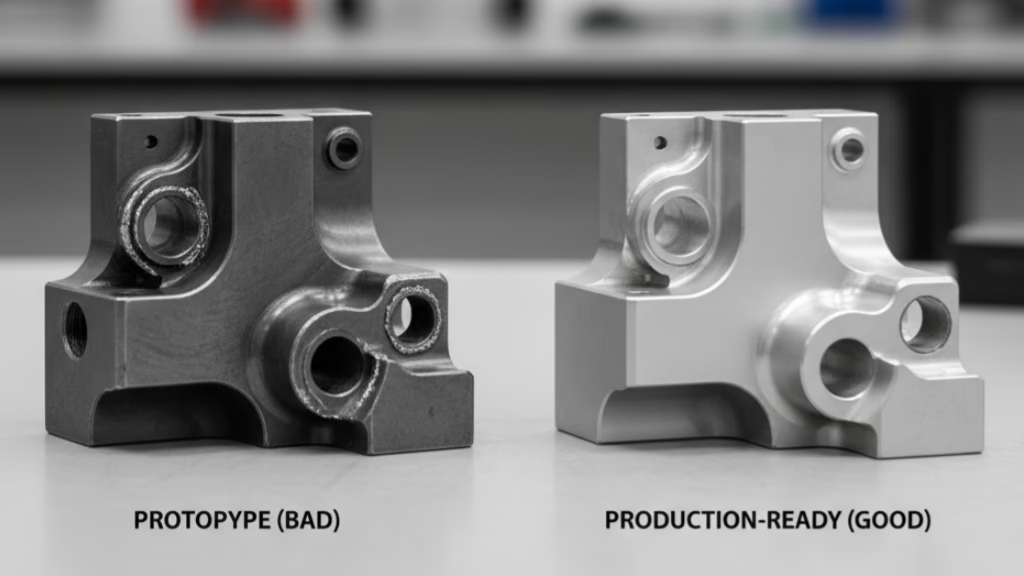Stop guessing whether a complex CMM inspection report is a “pass” or a costly “fail.” This guide is designed specifically for procurement managers, not quality engineers. You’ll learn exactly how to read a CMM report in 5 minutes to avoid critical supplier mistakes and make confident, data-driven decisions.
To read a CMM inspection report, first verify the part number and drawing revision (Rev) level are correct. Next, scan the summary for any “FAIL” or “OOT” (Out of Tolerance) flags. For any failures, compare the “Deviation” value to the “Tolerance” value to understand the severity.
The simple steps above are just the start. The real power comes from knowing how to spot a supplier’s “Golden Sample” and, more importantly, when a “FAIL” isn’t actually a reason to reject a shipment.
The “Nightmare Scenario” Every Procurement Manager Faces
Let’s set the scene. It’s 3:00 PM on a Friday. You’ve just received a 50-page CMM inspection report for a critical component. It’s covered in technical symbols and, worse, several lines are highlighted in red with the word “FAIL.”
Your supplier is emailing you for payment. The production line manager is calling you because they are waiting for this exact part.
You’re stuck.
Do you approve the shipment and hope for the best? Or do you reject it and risk shutting down production? This is the moment of decision paralysis every procurement manager dreads.
A single wrong choice could lead to costly line-down situations—which, as ASQ data suggests, can cost up to $22,000 per minute in some industries. Or, it could lead to a catastrophic quality recall down the line.
Here’s the good news: this guide is not going to turn you into a quality engineer. You don’t need to be a metrology expert.
Instead, this guide provides a decision-making framework for procurement professionals. We will give you a simple process to move past the technical jargon and regain control. You will learn how to read a CMM inspection report to get the only answer that matters: “What do I need to do next?”
We’ll solve this problem in three simple steps:
- Triage: A 5-minute quick review to catch critical errors.
- Interpret: A non-engineer’s guide to understanding risk.
- Act: A clear decision-making tree for what to do.
The 5-Minute Triage: Your First-Glance Checklist

Before you even try to understand a single measurement, you must perform a quick triage. This 5-minute check is designed to catch the 90% of “deal-breaker” problems that have nothing to do with complex engineering and everything to do with simple administrative errors.
Step 1: The Sanity Check (Don’t Skip This!)
This is the first thing you look at, and it’s the easiest place to get burned. I once had a procurement manager approve a $200,000 batch of custom-machined parts based on a “perfect” CMM report. When the parts arrived at the assembly line, not a single one would fit.
The problem? The supplier had built and inspected the parts against Rev B of the drawing. Our purchase order clearly specified Rev C.
That perfect report was 100% accurate… for the wrong part. It was a costly lesson. Before you look at any numbers, check these three things:
- Purchase Order (PO) Number: Does it match your PO?
- Part Number: Does it match your part number?
- Revision (Rev) Level: Does the drawing revision on the report exactly match the revision on your PO? If not, STOP. The entire report is invalid.
Step 2: The Overall Status
Once you’ve confirmed you’re looking at the right report, find the executive summary. Most CMM software will put a clear “PASS” or “FAIL” summary on the first page.
But don’t stop there. Look for the “Quantity Inspected.”
This is a critical insight. Did the supplier inspect 100% of the parts? Or did they inspect 5 parts out of a batch of 1,000?
Be wary of the “Golden Sample.” A dishonest or incapable supplier will produce 1,000 parts and then “cherry-pick” the five best-looking ones to send to their CMM lab.
They send you a beautiful report for those 5 “golden samples” while the other 995 parts in the box might be complete scrap. If the quantity is low, your risk is high.
Step 3: The Red Flag Scan
Now, quickly scroll through the entire document. You’re not reading for detail yet. You are just scanning for “OOT” (Out of Tolerance), “FAIL,” or any lines highlighted in red.
Get a quick mental tally.
- Are there just one or two minor red flags? (Okay, this is probably manageable).
- Or does the report look like it’s bleeding red ink, with 20 different features failing? (This indicates a serious, systemic quality problem with the supplier’s process).
This quick scan tells you the scale of the problem. Now that you’ve triaged the report, it’s time to interpret what those “FAIL” flags actually mean.
What Am I Actually Looking At?

Okay, so you’ve found a few “FAIL” flags. Your instinct might be to panic. Don’t. Not all failures are created equal. Now we need to interpret the risk.
This part is not as complex as it looks. You don’t need an engineering degree; you just need to know where to focus.
Decoding the Four Core Columns of Any CMM Report
When you look at the data table, you’ll be staring at a dozen columns. You can safely ignore most of them. Your focus should be on just these four:
- Nominal: Think of this as the “perfect” number. This is the exact dimension (the “nominal” value) specified by the engineer on the blueprint.
- Actual: This is the “reality” number. It’s what the CMM machine actually measured on the physical part.
- Tolerance: This is your “margin for error.” The engineer has defined an acceptable range (e.g., ±0.05 mm) around the nominal value. As long as the “actual” measurement falls inside this window, the part is acceptable.
- Deviation: This is the only number you really need to look at. The deviation is simply the difference between the Actual and the Nominal (
Actual - Nominal). Your job is to compare this number to the Tolerance.
If the Deviation value is within the Tolerance range, it’s a PASS. If it’s outside that range, it’s a FAIL. It’s that simple.
Is Your Supplier’s Quality Data Reliable?
A CMM report is only as good as the process behind it. Our comprehensive Quality Control system ensures every part we ship is fully verified and traceable, giving you data you can trust.
A Procurement Manager’s Risk Rating for GD&T
But what about all those scary symbols? You don’t need to memorize all 14 GD&T (Geometric Dimensioning and Tolerancing) symbols. You just need to ask one question:
“Is this a failure of SIZE or a failure of RELATIONSHIP?”
- Low Risk (Usually): A failure of Size. This includes simple dimensions like the length of an edge, the diameter of a hole, or the width of a slot. These are often less critical and may be easily corrected or accepted.
- High Risk (Warning!): A failure of Relationship (GD&T). This is where those symbols like Position, Flatness, or Profile come in. These symbols don’t control a single size; they control how one feature relates to another.
As GD&T expert Alex Krulikowski, founder of Effective Training Inc., explains, “GD&T is a language that describes the function of a part.” A failure here is a failure of its core function.
Here is your procurement golden rule: A “Relationship” (GD&T) failure almost always carries a higher risk of assembly failure. A hole can be the right size, but if its position is wrong, the bolt won’t go through, and your entire assembly line stops.
How to Act on What You See
You’ve triaged the report and interpreted the risk. Now comes the most important part: the decision. This is where you move from being a “report reader” to a “decision-maker.”
Here is a simple, three-part action plan based on what you found.
Scenario A: The Report is 100% “PASS”
This is the easy one, right? Almost.
Your Action: You can confidently approve the shipment and archive the CMM report for future traceability.
Your Advanced Insight: Before you celebrate, look one level deeper. A “PASS” from a new supplier, or on a difficult part, might just be that “Golden Sample” we talked about. This is where you graduate from tactical to strategic procurement.
Ask the supplier for their process capability data (Cpk). A good Cpk (ideally 1.33 or higher) proves they can make good parts consistently. A passing report with a low Cpk (under 1.33) just proves they got lucky this time.
This is what quality pioneer Dr. W. Edwards Deming meant when he advised to “Cease dependence on inspection to achieve quality… build quality into the product in the first place.” A high Cpk is the evidence of built-in quality. A simple “PASS” report is just evidence of inspection.
Scenario B: The Report has “FAILs” on Non-Critical Features
This is the most common scenario, and it’s where you can provide the most value to your company.
Your Action: Do NOT immediately reject the shipment!
I learned this the hard way. A dedicated, by-the-book procurement manager I knew once rejected an entire batch of parts because a single, non-critical chamfer dimension was out of tolerance by 0.03mm. He did the “right” thing according to the blueprint.
The result? The production line shut down for two days.
It turned out that feature had zero impact on the part’s function or assembly. He was technically correct but commercially disastrous.
Your job is to find the balance. When you see a non-critical “FAIL”:
- Walk the report over to your internal engineering or quality team.
- Ask the “Soul Question”: “I see this feature failed, but does it impact the part’s function or fit? Can we grant an engineering waiver or deviation for this batch?”
Nine times out of ten, the answer will be “It’s fine, use it as is.” By asking this question, you just saved the company from a costly, self-inflicted line-down. You managed risk instead of just reacting to a red line on a piece of paper.
Scenario C: The Report has “FAILs” on Critical Features
This is the moment all your preparation was for. When a critical feature (like a GD&T Position or a key functional dimension) is marked “FAIL,” your response must be immediate and firm.
Your Action: STOP. Do not pass go. Do not approve the part.
- Internally: Immediately notify your Supplier Quality Engineer (SQE) and engineering team.
- Externally: Place the entire batch on a “Quality Hold” or “Quarantine” status. Do not let it near your production floor.
- Formally: Issue a Non-Conformance Report (NCR) to the supplier.
At this moment, the CMM inspection report is no longer just a technical document.
It has become your most important commercial and legal tool, forming a critical component of your overall CNC supplier auditing process.
It is objective, data-driven proof of a contract breach. You will use this report to negotiate rework, replacements, or financial compensation for any damages caused by this failure.
CMM Report Decision Framework
| Scenario | Risk Level | Immediate Action | Strategic Question to Ask |
|---|---|---|---|
| 100% “PASS” | Low (but verify) | Approve & Archive | “Is this a ‘Golden Sample’ or can you provide Cpk data?” |
| “FAIL” on Non-Critical Feature | Medium | Consult Engineering | “Does this failure impact form, fit, or function? Can we grant a waiver?” |
| “FAIL” on Critical Feature (CD/KC) | High | Stop! Quarantine & Issue NCR. | “What is your root cause (RCA) and corrective action (CAR)?” |
You’re Not a “Report Reader”—You’re a “Report User”

That’s the entire process. Notice that your job isn’t just to “read” the CMM inspection report. Your real job is to use it.
A CMM report isn’t a technical exam you’re supposed to pass. It’s ammunition. It’s a tool that allows you to protect your company, manage risk, and make smarter financial decisions.
This framework is what separates a tactical buyer from a strategic procurement leader.
- A junior buyer sees “FAIL” and immediately rejects the part, potentially causing a line-down.
- A senior procurement manager sees “FAIL,” walks to engineering, and asks, “Does this non-conformance actually impact the function?” saving the company from a needless shutdown.
- A strategic sourcing partner, however, goes one step further. They use a “FAIL” report (and the Cpk data) to start a deeper conversation with the supplier. They don’t just fix the part; they collaborate to help the supplier fix their process. This lowers the total cost of ownership (TCO) permanently and builds a truly resilient supply chain.
From this moment on, stop treating a CMM report as an obstacle. Start treating it as your single most powerful negotiation tool.
Now, go find that report on your desk. It’s time to conduct your first strategic review. You now know exactly how to read a CMM inspection report and, more importantly, what to do about it.
Ready to Partner with a Supplier You Can Trust?
You’ve learned how to spot bad data. Now, experience the peace of mind that comes from working with a partner who builds quality in from the start. Let’s discuss your next project.
References & Notes
[1] Cost of Poor Quality (CoPQ): The $22,000/minute figure is a widely cited statistic related to the extreme costs of automotive assembly line downtime. The underlying concept, Cost of Poor Quality (CoPQ), is a core metric defined by the American Society for Quality (ASQ). It includes internal failure costs (scrap, rework) and external failure costs (recalls, warranty), which CMM report verification directly helps to prevent.
[2] Dr. W. Edwards Deming: A leading figure in quality management. His philosophy emphasized that quality improvement is a continuous process that reduces waste and increases productivity, rather than a one-time inspection event. His work forms the basis of modern quality control systems.
[3] Alex Krulikowski: A prominent expert in Geometric Dimensioning and Tolerancing (GD&T). His assertion that GD&T is a language of “function” is a foundational concept for engineers, helping them (and now procurement managers) understand that tolerances exist to ensure a part works as intended.




